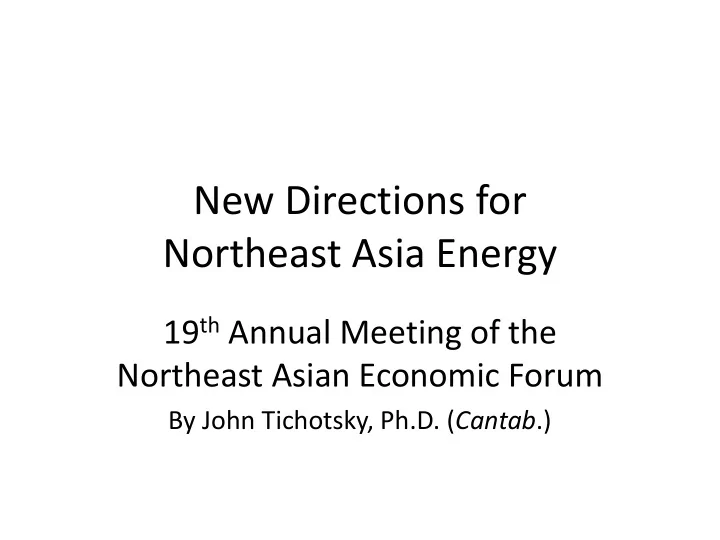

New Directions for Northeast Asia Energy 19 th Annual Meeting of the Northeast Asian Economic Forum By John Tichotsky, Ph.D. ( Cantab .)
Global Issues that Drive Northeast Asia Energy Issues • Aftermath of the global financial crisis • Recovery strategies of the Northeast Asian countries differ • Dynamic changes in the global economy translate as a significant change in the energy supply and demand equilibrium for Northeast Asian • As devastating as some of the changes might be, they also allow for unprecedented changes in policy and strategy in addressing changes in the structure of energy markets
NEAEF has been looking at Energy Demand Growth and Green Growth in NE Asia • Korea • China • Japan
Definition of Green Growth • Green translates as: – Low Carbon Emissions – Energy Conservation – Energy Efficiency • Growth, traditionally, is: – Increasing demand in energy • Seemingly inherent contradiction in linking the two concepts
“Green Growth” Strategies • Republic of Korea: “A National Vision” – Presidential Committee on Green Growth, – enacted legislation The Framework Act on Low Carbon Green Growth , and • China – An Inventory of Green Energy (Low Carbon) Economic Achievement • Japan – “Cool Growth” = low carbon emmissions • Russia – Export West is best…
Energy Supply and Demand • Depends on Price • In turn, depends on economic growth, and vice-versa • Green growth strategies – Decrease demand – Decrease price of energy, especially of traditional fuels • In turn, lack of incentive to promote green growth
Energy Security • Prediction of next energy crisis difficult • Costs of energy security is enormous • Costs includes collateral issues – Restrictions on trade – Expenditure on defense • “No nation was ever ruined by trade.” – Benjamin Franklin
Who invests in new technology ??
Where does new technology come from? • Large corporation R&D • Universities and research institutes • Government laboratories (including military and space programs) • Entrepreneurs
Technology • Recognition of LONG TIME TO IMPLEMENT from idea to mass use – At least 3 years from idea to proto- type – At least 3 years from proto-type to pilot plant – At least 2 years from pilot to mass use of technology – Elections cycles are much shorter…
Construction Innovation Relevant for Northeast Asia • Residential • Commercial • Public • Industrial
“Green” Construction Codes
The Resource is ENERGY
Back to Basics • Energy cannot be created or destroyed – it E=mc 2 can only be TRANSFORMED from one form to another http://images.theage.com.au/ftage/ffximage/2 008/11/21/einstein1_wideweb__470x314,0.jp g
The problem may be that fossil fuels are too cheap and are not scarce enough http://inflationdata.com/inflation/images/char ts/Oil/Inflation_Adj_Oil_Prices_Chart.htm
Why not use fossil fuels? http://static.howstuffworks.com/gif/dinosaur- images-002-resize.jpg
Depleting non-renewable resources to generate energy need NOT be SYNONOMOUS with emissions of greenhouse gases.
Do “future generations” need fossil fuels? http://capturethief.com/47G%20WHALE%2 0OIL%20LAMP%20SMALL%20BRASS%20cro http://img.dailymail.co.uk/i/pix/2007/06_02/ pped.jpg whaleDM1406_468x498.jpg
Goal of reduction of emissions
Lower carbon emissions through traditional resources • WHAT ABOUT NATURAL GAS?
Combustion of fossil fuels • Coal 2 C 10 H 2 + 21 O 2 ----> 2 H 2 O + 20 CO 2 + Energy • Gasoline 2 C 8 H 18 + 25 O 2 ----> 18 H 2 O + 9 CO 2 + Energy • Methane (natural gas) CH 4 + 2 O 2 ----> 2 H 2 O + CO 2 + Energy
Available Infrastructure for Natural Gas and LNG
But not in Northeast Asian – no gas pipeline projects Source: eneken.ieej.or.jp/en/data/pdf/240.pdf
Japan has the “reverse” of US problem No good pipeline infrastructure
Japan Natural Gas Pipeline Case Study • A realistic option for Japan might be to bring more natural gas into the Japanese markets. • Currently, Japan has no real internal trunk-line pipeline infrastructure and almost all natural gas is brought in by about 25 Liquefied Natural Gas Terminals.
• Historically, there has been no incentive for Japan to create a domestic or international gas pipeline network, in contrast to Republic of Korea.
WHERE WILL THE MONEY FOR ENERGY INFRASTRUCTURE COME FROM??
Long term trend for Natural Gas Prices
NEW NATURAL GAS SOURCES ? Methane hydrate is natural gas super- compressed (120 times) within an ice crystal There is more gas in methane hydrates than conventional gas
Methane Hydrate-North America Petroleum System I nfrastructure Technology ALASKA Econom ics & Risk ONSHORE GULF OF MEXI CO
Recommend
More recommend